A treasure at the farm: the native miner-bee colony
When we were buying this farm one of the owners walked us around to a red clay patch of bare dirt on the east side of the house. It’s an area under an addition that juts out over a steep slope. A series of tiny arched entrances the size of your fingertip covered the slope like an adobe village in miniature. This was the first time I had ever seen a colony of miner bees or chimney bees…
Read MoreCultivating the Wild Suburbia – Good Blog Read!
From “Cultivating the Wild Suburbia”by Ellen Honeycutt:
Contrary to what you might think, suburbia is a place where we can create habitat. That is my goal in our yard. I create habitat by making conscious decisions such as: plant a diverse mix of regionally native plants; minimize the use of chemicals; create places of habitat by leaving some dead trees, some bare ground, some brush piles; research what I plant to have bloom times throughout the year for pollinator support. [photo via site]
… read the excellent post on the joys of creating backyard habitat in the full post Cultivating the Wild Suburbia from our friends at www.beautifulwildlifegarden.com.
Read MoreLove this plant! Panicle Hydrangea
Any plant that attracts this kind of beauty on a daily basis is going to win points with me!
Read MoreHappy Accident in the Weedy Pasture…
Sometimes, things get away from you before you can weedeat! Take this tiny pasture which has thin rocky soil and gets half shady in the fall. I’ve had no luck in growing anything I wanted to grow in it. I intended to knock back the weeds all summer, which at the time were about knee-high, with generic-looking green stalks. (Let me note here, that we never needed a weedeater when we had goats!)
Then the brush got chest high and I dreaded the nightmare weedeating job and put it off longer because now it would involve the gasoline weedeater vs. the lightweight electric. But it was funny to let the chickens run around in their own personal chicken maze, completely invisible once they entered, and scratch around to their hearts’ content. And by then it was far too large for even a herd of biddies to hurt.. Finally, it got so close to first frost that I decided to let winter take it all down….sigh of relief.
But before that happened, everything bloomed. WOW! I’m not sure what these little white aster-like weeds are (anyone?) but the flowers cover the pasture now. And I have never seen so many pollinators in one place at one time! There have been native bees, butterflies, flower flies, and of course the Larrapin honeybees have been all over it. Meanwhile, all kinds of songbirds are hanging around the perimeter have a feast on all the various bugs. (Stay away from the bees you guys!)
You can stand in the middle of it be surrounded by a lively buzz and every flower, I mean every one, has somebody enjoying it. Amazing! My bee mentor told me how much-loved this wildflower is (as one of the last nectar sources of the year) because light frosts actually make the plant produce more nectar.
I’m so very glad I procrastinated this time. Now I have a whole different outlook on this particular “weed.” While I’m a farmer at heart, at the same time, I love what nature does to the land when the farmer steps back a bit and let’s the real master-gardener show me how it’s done! Hope you all are enjoying this beautiful Ozark fall.
—A Larrapin Garden www.larrapin.us
Posts most wednesdays & weekends. Don’t miss any—you can subscribe by Email here. You can also get bonus links and recipes by “liking” our Facebook fan page atwww.facebook.com/larrapin.garden. We’re even on Twitter at http://twitter.com/LarrapinGarden.
No new plastic, continued. And Water for Wildlife.
As I wrote in the last post, one of my farm lessons this year is to avoid plastic farm buckets, well, except when it’s hard to replace or it’s what you have already... Still, my commitment to metal, wood, stone, pottery and concrete is growing. As the plastic stuff breaks or cracks (set your watch!) I’m transitioning to metal and concrete to hold water. The plastic wildlife dishes—which I already had and will use till they wear out—are changing to the concrete birdbath tops you can find at Lowe’s. (Like the photo below, from a previous post on providing water to wildlife.)
I’d love to make some my own wildlife bowls from concrete too…<nudge to Liz here> I would shape them with the very shallow and sloping sides that the bees love on one old birdbath shown below. They love it because even when the water level goes down, they can still reach it from the safety of dry concrete. A bee can drown in just about anything, but with this design they can climb out to safety, unlike a steep or slick side. It’s so popular we call it the bee-beach and we had to add another bath for the birds the bees displaced from that one! No, the bees do not like birds on their beach and will make that known.
The birds love the rough concrete texture and shallow pool too as it makes for safe footing while bathing. With such a shallow dish, you have to refill often, but that works to eliminate mosquitos since if you ignore it you will have a dry bowl in about 48 hours. Not that you would let it go dry since everything needs water now. The queue to every bird dish we have is several birds deep on many hot afternoons.
Even with deeper wildlife dishes, as long as you dump and refill every 5 days or so, you’ll never raise any mosquitos since they take 7 days to mature… If you are just starting to provide water for wildlife, remember to have containers at ground level as well as traditional birdbaths. There are many critters that can’t drink from an elevated birdbath…like rabbits, turtles, skinks, lizards, etc. (But nix all this info if you have free roaming cats—you don’t want to lure wild creatures to their death.)
Keeping fresh, accessible and safe water sources in many areas around Larrapin has increased the bird and wildlife more than any other single thing we’ve done. How do you provide water for wildlife in your garden?
—A Larrapin Garden www.larrapin.us
Posts most wednesdays & weekends. Don’t miss any—you can subscribe by Email here. You can also get bonus links and recipes by “liking” our Facebook fan page atwww.facebook.com/larrapin.garden. We’re even on Twitter athttp://twitter.com/LarrapinGarden.












